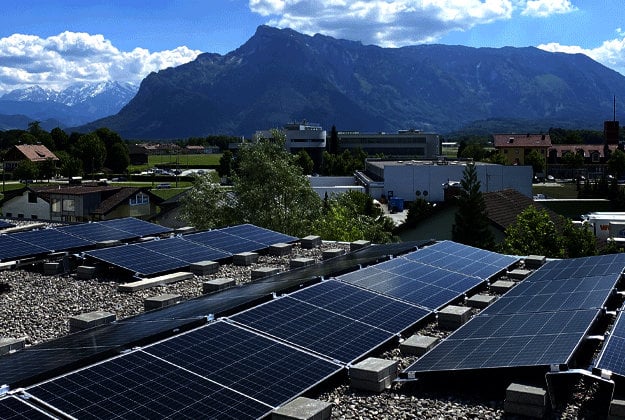Sunny prospects
At the end of June 2020, a 70-panel photovoltaic system was installed on the roof of the COPA-DATA headquarters in Salzburg and went into operation. More than one third of the location’s annual electricity demand will now be generated directly on site and be fed into the local grid of Salzburg AG. In addition, the system will serve as a testbed for the further development of zenon engineering for PV systems.

“We have been planning to install a PV system on our roof for a long time. Now it has finally been implemented and is running very well,” explains CEO and company founder Thomas Punzenberger. “For years we have been using only green electricity. Now we are generating it ourselves. Our employees are very pleased about this. Plus, it has an extra added value for us: since our customers already use our zenon software platform successfully to monitor renewable energies, we will be using the new system for the further development of our software for this purpose.”
The COPA-DATA building is gradually being developed into a Smart Building, even though it was not designed as such when it was built over 18 years ago. The company is using its own zenon software platform to do this because zenon can easily connect the various controls and sensors of blinds, lighting circuits, heating systems and the PV system. The software visualizes everything clearly and automates many operations.
Facts and figures about the new plant
- Set up by Revolta from Pill in Tirol, Austria
- Orientation of the plant in an east-west direction
- 70 photovoltaic panels on 4 strings with 1 inverter, which supplies a constant 750 volt current
- Maximum peak power 45.54 KWp; maximum reached so far approx. 40 KW
- Direct feed into the Salzburg AG grid
- Within the first six weeks, 9 MWh were generated. This roughly corresponds to a 3.5 t carbon dioxide saving or 106 planted trees
The integration of zenon
COPA-DATA’s zenon software platform already controls and monitors numerous projects in the field of renewable energies, including distributed hydropower plants in Slovenia, large solar parks in Jordan and wind power plants with energy storage systems in South Korea.
“We have been able to gain international expertise in this area and have constantly expanded our range of services,” explains Lewis Williams, Industry Specialist for Energy & Infrastructure at COPA-DATA. “For us, the inhouse PV system on the roof offers a good opportunity to conduct inhouse research. This applies in particular to engineering, as we want to make it as easy as possible for project managers and system integrators to implement their projects safely and conveniently with zenon.”
COPA-DATA is working on making zenon applications for the control and monitoring of PV systems even more user-friendly and comprehensive. The aim is to find out which software modules are useful in order to optimize the monitoring accuracy of the PV system. This depends largely on whether the power is measured at string or inverter level, the size of the entire system and which sensors and panel types are used.
“With our own system, we would now like to test exactly how the control of sun aligners can be optimized depending on the method used. At the same time, we want to learn more about the measurements of different sensors (temperature, wind, radiation, soiling) and their influence on increasing the efficiency of a solar plant. We also want to detect underperforming panels more accurately in order to improve rapid diagnostics. This is currently one of the most significant hurdles to achieving optimal utilization of a PV system,” explains Lewis Williams.
www.copadata.com

